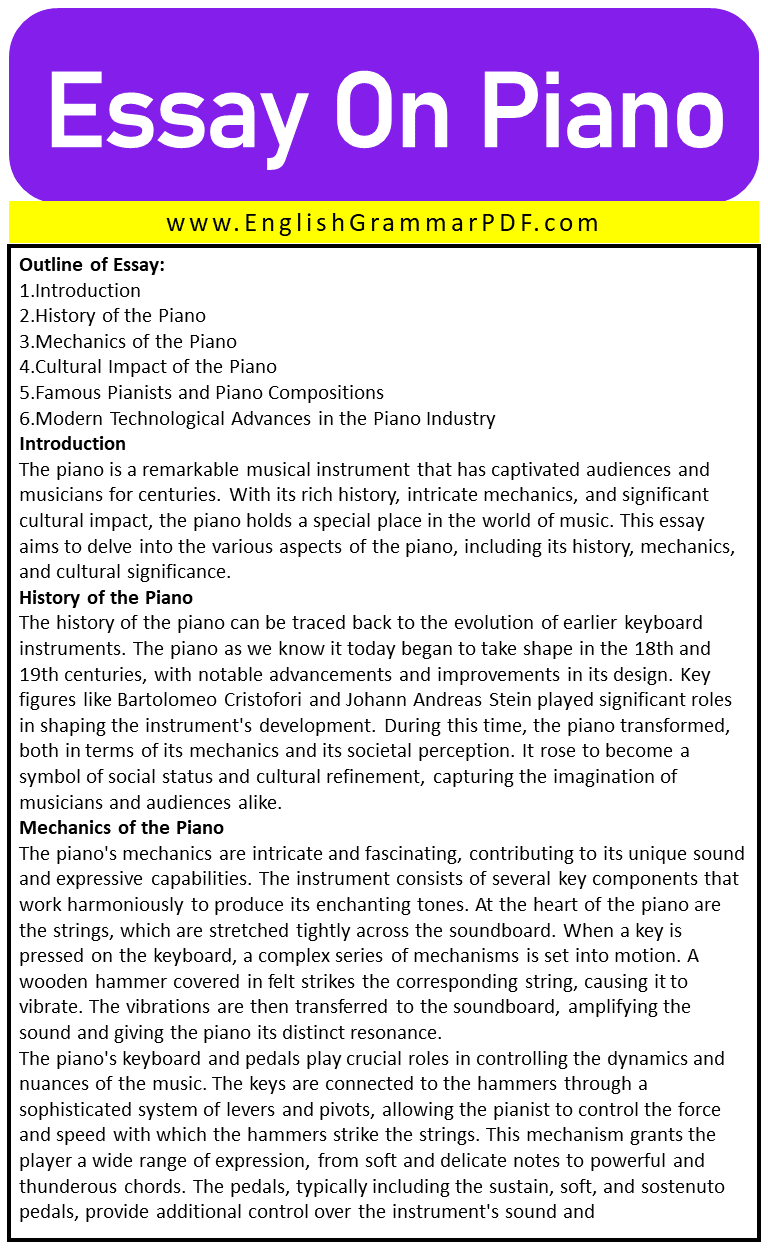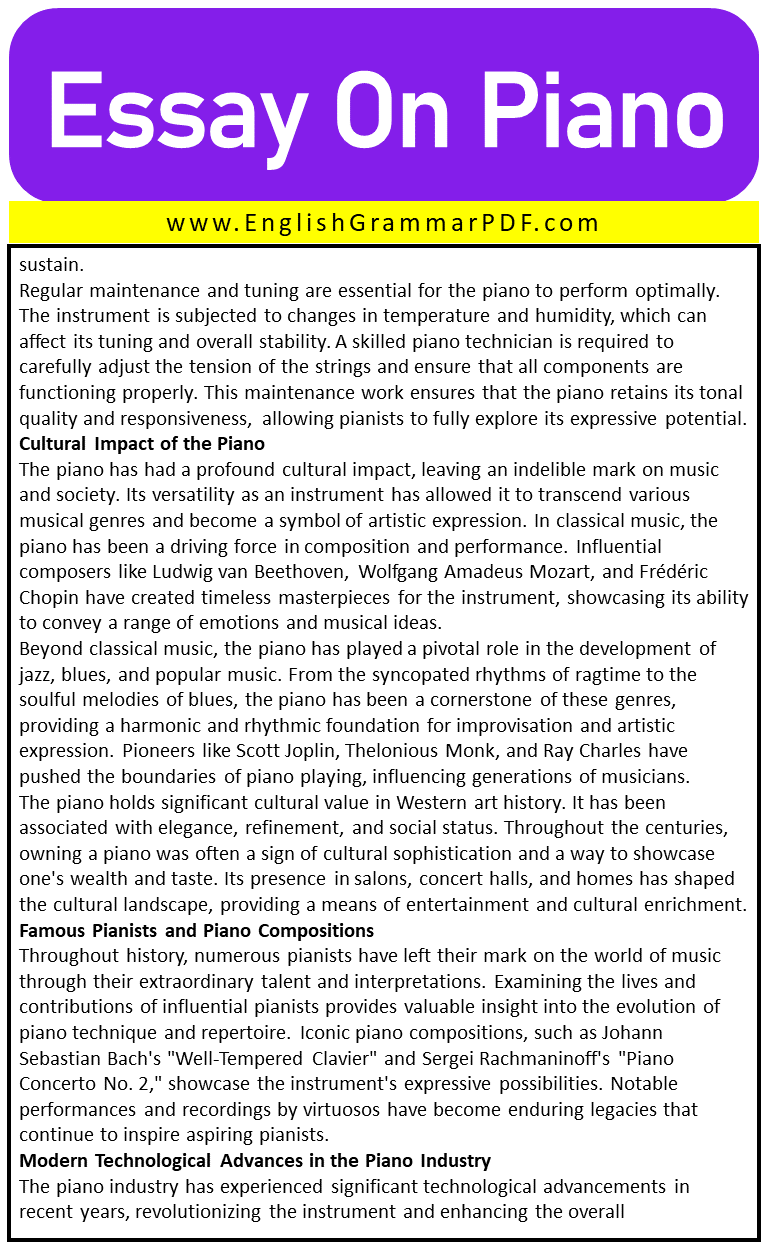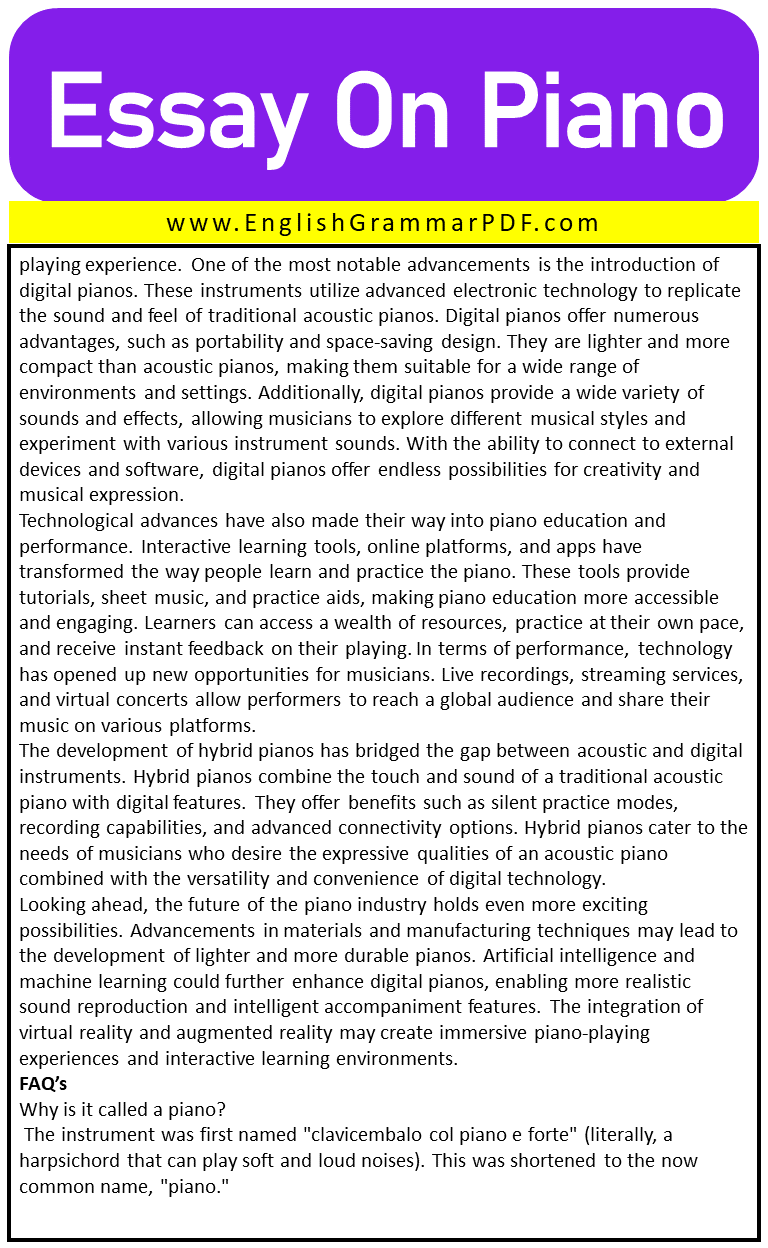Essay On Piano
Outline of Essay:
- Introduction
- History of the Piano
- Mechanics of the Piano
- Cultural Impact of the Piano
- Famous Pianists and Piano Compositions
- Modern Technological Advances in the Piano Industry
Introduction
The piano is a remarkable musical instrument that has captivated audiences and musicians for centuries. With its rich history, intricate mechanics, and significant cultural impact, the piano holds a special place in the world of music. This essay aims to delve into the various aspects of the piano, including its history, mechanics, and cultural significance.
History of the Piano
The history of the piano can be traced back to the evolution of earlier keyboard instruments. The piano as we know it today began to take shape in the 18th and 19th centuries, with notable advancements and improvements in its design. Key figures like Bartolomeo Cristofori and Johann Andreas Stein played significant roles in shaping the instrument’s development. During this time, the piano transformed, both in terms of its mechanics and its societal perception. It rose to become a symbol of social status and cultural refinement, capturing the imagination of musicians and audiences alike.
Mechanics of the Piano
The piano’s mechanics are intricate and fascinating, contributing to its unique sound and expressive capabilities. The instrument consists of several key components that work harmoniously to produce its enchanting tones. At the heart of the piano are the strings, which are stretched tightly across the soundboard. When a key is pressed on the keyboard, a complex series of mechanisms is set into motion. A wooden hammer covered in felt strikes the corresponding string, causing it to vibrate. The vibrations are then transferred to the soundboard, amplifying the sound and giving the piano its distinct resonance.
The piano’s keyboard and pedals play crucial roles in controlling the dynamics and nuances of the music. The keys are connected to the hammers through a sophisticated system of levers and pivots, allowing the pianist to control the force and speed with which the hammers strike the strings. This mechanism grants the player a wide range of expression, from soft and delicate notes to powerful and thunderous chords. The pedals, typically including the sustain, soft, and sostenuto pedals, provide additional control over the instrument’s sound and sustain.
Regular maintenance and tuning are essential for the piano to perform optimally. The instrument is subjected to changes in temperature and humidity, which can affect its tuning and overall stability. A skilled piano technician is required to carefully adjust the tension of the strings and ensure that all components are functioning properly. This maintenance work ensures that the piano retains its tonal quality and responsiveness, allowing pianists to fully explore its expressive potential.
Cultural Impact of the Piano
The piano has had a profound cultural impact, leaving an indelible mark on music and society. Its versatility as an instrument has allowed it to transcend various musical genres and become a symbol of artistic expression. In classical music, the piano has been a driving force in composition and performance. Influential composers like Ludwig van Beethoven, Wolfgang Amadeus Mozart, and Frédéric Chopin have created timeless masterpieces for the instrument, showcasing its ability to convey a range of emotions and musical ideas.
Beyond classical music, the piano has played a pivotal role in the development of jazz, blues, and popular music. From the syncopated rhythms of ragtime to the soulful melodies of blues, the piano has been a cornerstone of these genres, providing a harmonic and rhythmic foundation for improvisation and artistic expression. Pioneers like Scott Joplin, Thelonious Monk, and Ray Charles have pushed the boundaries of piano playing, influencing generations of musicians.
The piano holds significant cultural value in Western art history. It has been associated with elegance, refinement, and social status. Throughout the centuries, owning a piano was often a sign of cultural sophistication and a way to showcase one’s wealth and taste. Its presence in salons, concert halls, and homes has shaped the cultural landscape, providing a means of entertainment and cultural enrichment.
Famous Pianists and Piano Compositions
Throughout history, numerous pianists have left their mark on the world of music through their extraordinary talent and interpretations. Examining the lives and contributions of influential pianists provides valuable insight into the evolution of piano technique and repertoire. Iconic piano compositions, such as Johann Sebastian Bach’s “Well-Tempered Clavier” and Sergei Rachmaninoff’s “Piano Concerto No. 2,” showcase the instrument’s expressive possibilities. Notable performances and recordings by virtuosos have become enduring legacies that continue to inspire aspiring pianists.
Modern Technological Advances in the Piano Industry
The piano industry has experienced significant technological advancements in recent years, revolutionizing the instrument and enhancing the overall playing experience. One of the most notable advancements is the introduction of digital pianos. These instruments utilize advanced electronic technology to replicate the sound and feel of traditional acoustic pianos. Digital pianos offer numerous advantages, such as portability and space-saving design. They are lighter and more compact than acoustic pianos, making them suitable for a wide range of environments and settings. Additionally, digital pianos provide a wide variety of sounds and effects, allowing musicians to explore different musical styles and experiment with various instrument sounds. With the ability to connect to external devices and software, digital pianos offer endless possibilities for creativity and musical expression.
Technological advances have also made their way into piano education and performance. Interactive learning tools, online platforms, and apps have transformed the way people learn and practice the piano. These tools provide tutorials, sheet music, and practice aids, making piano education more accessible and engaging. Learners can access a wealth of resources, practice at their own pace, and receive instant feedback on their playing. In terms of performance, technology has opened up new opportunities for musicians. Live recordings, streaming services, and virtual concerts allow performers to reach a global audience and share their music on various platforms.
The development of hybrid pianos has bridged the gap between acoustic and digital instruments. Hybrid pianos combine the touch and sound of a traditional acoustic piano with digital features. They offer benefits such as silent practice modes, recording capabilities, and advanced connectivity options. Hybrid pianos cater to the needs of musicians who desire the expressive qualities of an acoustic piano combined with the versatility and convenience of digital technology.
Looking ahead, the future of the piano industry holds even more exciting possibilities. Advancements in materials and manufacturing techniques may lead to the development of lighter and more durable pianos. Artificial intelligence and machine learning could further enhance digital pianos, enabling more realistic sound reproduction and intelligent accompaniment features. The integration of virtual reality and augmented reality may create immersive piano-playing experiences and interactive learning environments.
FAQ’s
Why is it called a piano?
The instrument was first named “clavicembalo col piano e forte” (literally, a harpsichord that can play soft and loud noises). This was shortened to the now common name, “piano.”
What is unique about the piano?
The piano is technically a stringed instrument, played percussively. However, unlike, say, a violin, the piano is played percussively with little hammers hitting its strings to produce sound.
Explore More Essays:
Download the PDF of the Essay:






